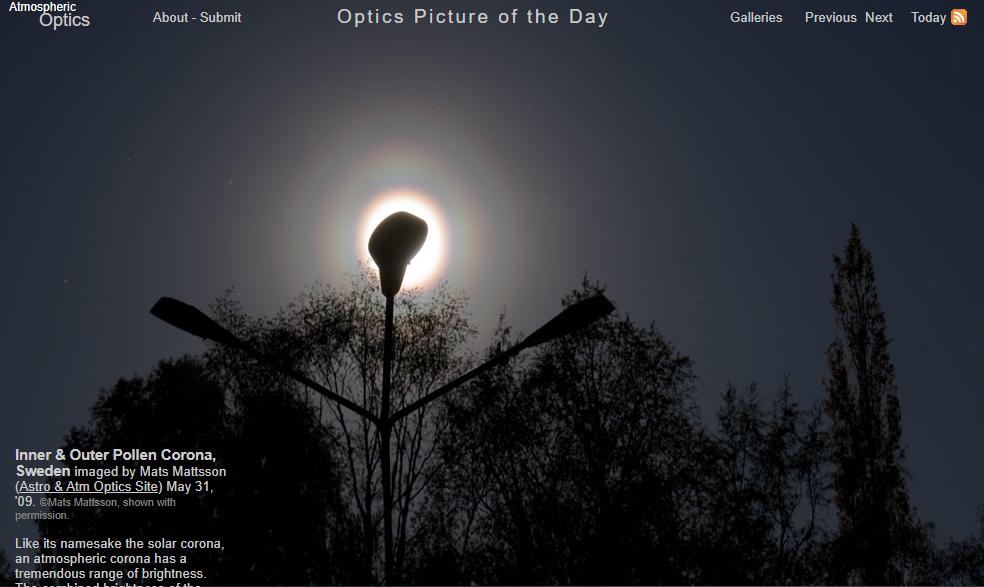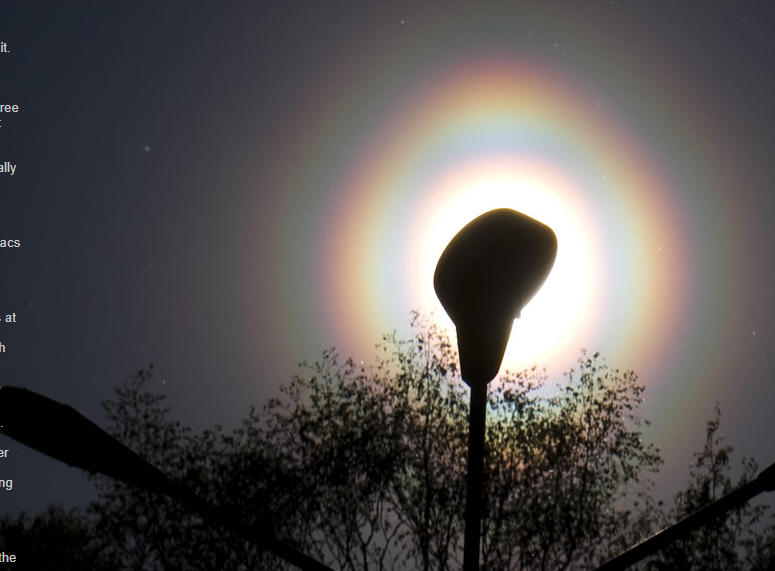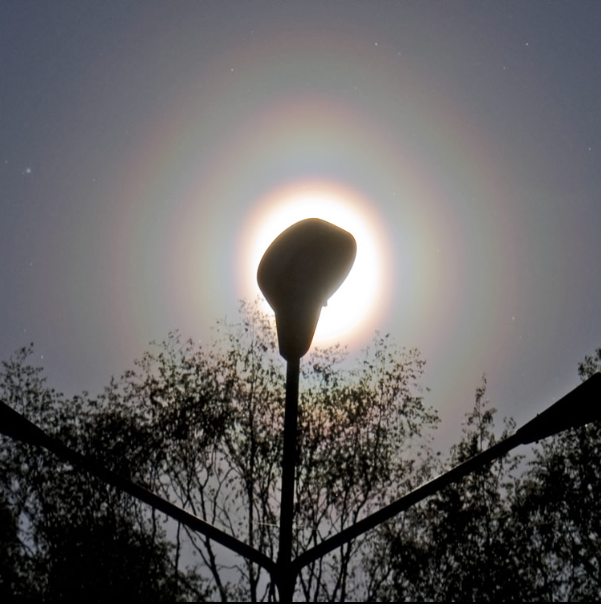Inner & Outer Pollen Corona, Sweden
Inner & Outer Pollen Corona, Sweden: A Delicate Display of Atmospheric Optics
Atmospheric coronas, like their solar counterparts, exhibit a wide range of brightness. However, the combined brightness of the rings in a pollen corona is only a mere 2% of that of the central aureole, with each ring progressively fainter than the one inside it.
Capturing the intricate details of a pollen corona in a single image can be challenging. However, by saving the exposure as a RAW file, photographer Mats Mattsson successfully overcomes this hurdle. Through processing the image with different 'exposures,' three distinct versions are produced, each revealing unique features of the corona.
One characteristic feature that is evident in all three images is the presence of vertically elongated rings. These rings are formed by pollen particles that diffract light and exhibit asymmetric shapes. The brightenings observed within the rings can be attributed to the air sacs present in these particles, which cause them to align preferentially in the air.
Among the processed images, the one on the right provides a particularly vivid display of ring brightenings resulting from the presence of these asymmetric particles. Meanwhile, the second image showcases delicate hues of straw, pink, and red at the outer rim of the aureole. These colors arise due to longer wavelength aureoles being larger in size.
The rings within a pollen corona display a multitude of complex hues. This complexity arises from the overlapping of different colors within the rings, creating a visually captivating display. While the relative intensities of the rings may appear flattened in the lower image, it still reveals the outer structure of the corona, exhibiting at least three and possibly four rings.
Pollen coronae are known to possess multiple rings due to the monosized nature of the diffracting particles. These particles diffract light at specific angles, resulting in the formation of concentric rings of varying intensities. The presence of these rings adds to the intricacy and beauty of the corona.
The images presented in this study provide a glimpse into the captivating world of pollen coronae. However, it is worth noting that the display of these subtleties may be limited by current monitor screen capabilities. As technology progresses, future advancements in monitor screens, such as 128-bit displays, may enable better visualization of the intricate details and colors within pollen coronae.
In conclusion, the inner and outer pollen corona observed in Sweden showcases the mesmerizing beauty of atmospheric optics. The rings, formed by diffracting pollen particles, exhibit a wide range of hues and complex overlapping colors. Through the skilled photography of Mats Mattsson, we gain a deeper appreciation for the delicate and awe-inspiring nature of pollen coronae. As we continue to explore and understand atmospheric phenomena, advancements in technology may further enhance our ability to appreciate the subtle intricacies of these captivating optical displays.

Inner & Outer Pollen Corona, Sweden imaged by Mats Mattsson (Astro & Atm Optics Site) May 31, '09. ©Mats Mattsson, shown with permission.
Like its namesake the solar corona, an atmospheric corona has a tremendous range of brightness. The combined brightness of the rings is only 2% of that of the central aureole and each ring is much fainter than the one inside it.
A single image has difficulties in coping but here Mats' exposure saved as a RAW file does so. Three versions processed with different 'exposures' reveal the features.
All show the characteristic vertically elongated rings of a pollen generated corona. The image at right best shows the ring brightenings resulting from the asymmetric particles whose air sacs give them a preferred aerial orientation.
The second image captures the delicate straw, pink and red hues at aureole's outer rim. The colours result because longer wavelength aureoles are the larger.
The rings show a whole range of complex hues, complex because there is much colour overlapping.
The lower image reveals the outer structure with at least three and possibly four rings. The processing necessarily flattens the relative intensities of the rings.
Pollen coronae have many rings because the particles diffracting the light are monosized.
Some day we might have 128 bit monitor screens to display better these subtleties.
More about:
Corona
Formation by diffraction
Colours
Pollen coronae
HDR Corona


Note: this article has been automatically converted from the old site and may not appear as intended. You can find the original article here.
Reference Atmospheric Optics
If you use any of the definitions, information, or data presented on Atmospheric Optics, please copy the link or reference below to properly credit us as the reference source. Thank you!
-
<a href="https://atoptics.co.uk/blog/inner-outer-pollen-corona-sweden/">Inner & Outer Pollen Corona, Sweden</a>
-
"Inner & Outer Pollen Corona, Sweden". Atmospheric Optics. Accessed on April 25, 2024. https://atoptics.co.uk/blog/inner-outer-pollen-corona-sweden/.
-
"Inner & Outer Pollen Corona, Sweden". Atmospheric Optics, https://atoptics.co.uk/blog/inner-outer-pollen-corona-sweden/. Accessed 25 April, 2024
-
Inner & Outer Pollen Corona, Sweden. Atmospheric Optics. Retrieved from https://atoptics.co.uk/blog/inner-outer-pollen-corona-sweden/.